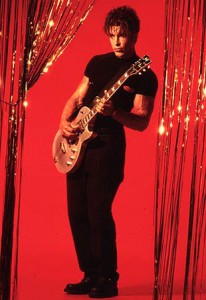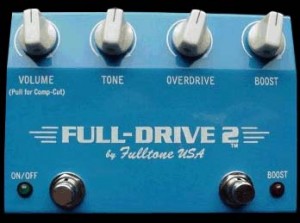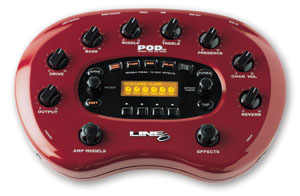 Recently at the past 2004 NAMM show, Marshall formally unveiled its latest line of amplifiers – vintage recreations called the Hand Wired series. For many vintage amp tone enthusiasts (myself included), this was just the move that we had hoped Marshall would someday make.
Recently at the past 2004 NAMM show, Marshall formally unveiled its latest line of amplifiers – vintage recreations called the Hand Wired series. For many vintage amp tone enthusiasts (myself included), this was just the move that we had hoped Marshall would someday make.
Read More »
All posts by David Szabados
Analog Chorus Roundup Review
I had recently picked up a chorus unit as I was interested in adding some thickened multi-guitar sounds to my rig. It had been years since I had played with chorus units, seeing as I had largely overdone the effect in the ‘80s as many other players did. I thought however that now would be a good time since I have more taste now to be able to use the effect more sparingly.
Read More »
Keeley Electronics DS-1 Seeing Eye Mod
Robert Keeley’s name has grown substantially over the past couple of years and with good reason: he’s an electrical engineer by trade blessed with a musician’s ear for good tone. That combination has proved to be a blessing for his business, Keeley Electronics, and has earned Robert the reputation of knowing what sounds good and being able to build those tones into his final products for his customers.
Read More »
George Lynch Interview
 George Lynch remains one of the great rock stylists of our time. With a history that stems from his early work throughout the ’80s with Dokken, to various solo albums as well as with his current group, Lynch Mob, George Lynch continues to forge ahead and explore various new territories of rock musical styles and tone.
George Lynch remains one of the great rock stylists of our time. With a history that stems from his early work throughout the ’80s with Dokken, to various solo albums as well as with his current group, Lynch Mob, George Lynch continues to forge ahead and explore various new territories of rock musical styles and tone.
With two new albums out and multiple projects ahead, George was kind enough to take time away from his hectic recording and touring schedule to give LegendaryTones the low-down on his music as well as the topics of tone, technique, and the future. Check out his site at www.georgelynch.com and enjoy!
Read More »
Fulltone Fulldrive 2 Review
 Overdrive and distortion pedals, particularly vintage models from companies such as Ibanez (check out TS-808 tube screamer prices on Ebay), Boss (OD-1 very collectable), MXR, etc., have been very popular lately. One reason is of course primarily the tone that they offer. The other, is that plain and simply, they’re just built better than what you can commercially get today. I recently opened up an old MXR distortion plus and was impressed that it had not one, but four signed signatures on it, for testing and “signing off” on the unit during various stages of construction. You don’t often see that kind of care being taken when building pedals anymore. These days, it is about getting the bottom line (i.e. the cost) down to as little as possible. Even companies such as Boss that mass-produced many units since the ‘70s, did an excellent job and the quality was top notch while the pedals were being produced in Japan. Now, is well, another story.
Overdrive and distortion pedals, particularly vintage models from companies such as Ibanez (check out TS-808 tube screamer prices on Ebay), Boss (OD-1 very collectable), MXR, etc., have been very popular lately. One reason is of course primarily the tone that they offer. The other, is that plain and simply, they’re just built better than what you can commercially get today. I recently opened up an old MXR distortion plus and was impressed that it had not one, but four signed signatures on it, for testing and “signing off” on the unit during various stages of construction. You don’t often see that kind of care being taken when building pedals anymore. These days, it is about getting the bottom line (i.e. the cost) down to as little as possible. Even companies such as Boss that mass-produced many units since the ‘70s, did an excellent job and the quality was top notch while the pedals were being produced in Japan. Now, is well, another story.
Read More »
Line6 PODxt
 Line6’s original POD unit has been wildly successful since its inception just a few short years ago and with good reason. Any guitarist can imagine the appeal of having a musical tool that can call up a variety of guitar tones instantly at the push of a few buttons and a twist of a few knobs. In fact, having this versatility in a small package made the original POD a mainstay for studio musicians and recording studios.
Line6’s original POD unit has been wildly successful since its inception just a few short years ago and with good reason. Any guitarist can imagine the appeal of having a musical tool that can call up a variety of guitar tones instantly at the push of a few buttons and a twist of a few knobs. In fact, having this versatility in a small package made the original POD a mainstay for studio musicians and recording studios.
While a new loyal group of Line6 users embraced this digital modeling technology used in the original POD, some musicians were quick to judge negatively against the POD and modeling technology in general – even if they never had tried it in the first place! It is interesting that while we as musicians like to think of ourselves as individuals, we can also sometimes be "set in our ways" (how many of us play Strats, Pauls, and PRS’ or Marshall and Mesa Boogie amps in part because so-and-so does?) – and no debate has been stirred up with so much passion over recent years than the topic of "modeling vs. the real thing." It’s easy to see modeling-critics ripping apart these solutions, not only because they promise a plethora of the greatest tones according to how they are marketed, but also because they are simply new and perhaps threaten the status quo of how music is to be made and heard.
Read More »
Boosting Mystery: How and Why They Work!
As most LegendaryTones readers know, we’re an information site dedicated to writing features, tips, and artist profiles, all in the name of great guitar tone. But what some of you may not know is that we introduced our first product, the Time Machine Boost, a little over two years ago. And other than a banner ad on the front home page in the bottom left corner, we’ve made sure that we would never use the site for overdoing the promotion of the Time Machine Boost, and we still will not.
However, with that said, there are quite a few misconceptions about how boosts work and what they are used for versus an overdrive stompbox for example. I’ve received many e-mails asking questions about boosting applications and have replied to all of them. When the last question came in that asked why they couldn’t just usual a volume pedal instead of a boost, that’s when I decided to finally take this subject and put it all into the context of an article.
Read More »
Aerosmith 2002 Tour Gear
This past November, I had the pleasure to attend the Aerosmith show at the Shoreline in the Bay Area, with the added treat of being able to go backstage in the tech area prior to the show to get the full lowdown on what else? – the gear! I have to thank Brad Whitford’s personal guitar tech, Greg Howard, as well as Brad himself for taking the time out to meet with me and chat.
The stage sound during the show was perfectly mixed and sounded great. Joe Perry and Brad Whitford’s setups were both for the most part straightforward and based around the use of some of the best vintage guitars and amps along with a limited use of effects.
Read More »
Hughes and Kettner Tube Factor Overdrive/Distortion Pedal
Overdrive pedals that incorporate tubes have been around for many years. As the designs themselves have progressed, the sound of these devices have also improved significantly. For example, initially tube overdrive pedals ran the preamp tube or tubes with very low voltages and this changed the sonic characteristics of the effect. Many of today’s units however now run the tubes at the high plate voltages (in the neighborhood of 300 volts!) that the tubes were intended to be operated at.
In the months ahead, we hope to bring you a roundup of many different models of tube overdrive pedals. For now, we’ve taken a look at an especially impressive model: Hughes and Kettner’s Tube Factor.
Read More »
Vacuum Tube Basics
While digital modeling has caught the attention of many players today, tubes and tube amps are far from dead. And even with the new digital modeling technology, which indeed is designed to try and emulate the sounds of world-famous tube amps from the past and present, there seems to be a resurgence in the number of tube amp options that are out there. One of the strengths of a good tube amp is its ability to respond to the dynamics of a guitar player’s picking attack when a tube is being overdriven. In addition, no solid-state or digitally modeled amplifier sounds as good as a tube amp when played over a loud band. In fact, it is at loud volumes where tube amps really come alive, while solid state and digitally modeled amps will often become thin and have harsher high-frequency emphasized tones.
Since tube amps and tubes themselves are certainly here to stay, I thought it would be appropriate to talk about vacuum tube basics. This article’s purpose is simple: to discuss what tubes do, describe the different tube types and how they each sound. Afterward, we’ll discuss briefly about what to look for when shopping for tubes and getting them installed.
Read More »